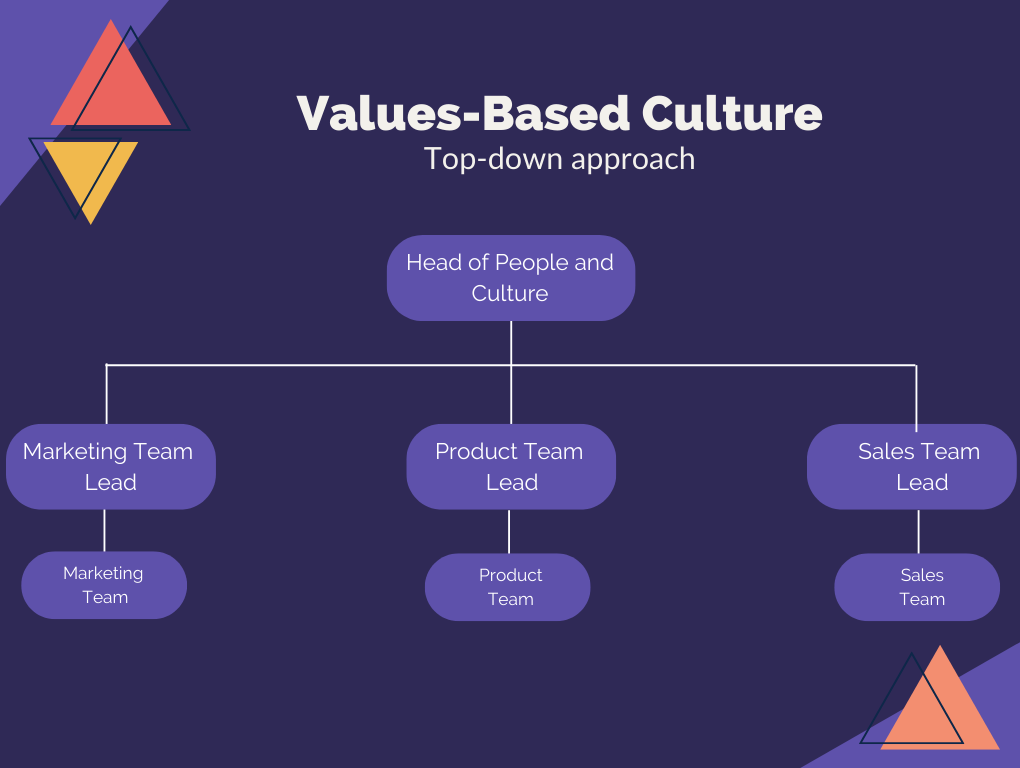Consider this scenario: The marketing team at Company XYZ has been asked by their team leader to collaborate on creative ways to increase customer revenue; however, communication and problem-solving have been lacking, and as a result, effective decisions can’t be made.
The marketing team leader has come to The Head of People and Culture to ask his advice on how she can improve collaboration in her department. In trying to solve this problem, the Head of People and Culture is left with little guidance on how to proceed.
Engaging in team-building activities, such as scavenger hunts or high-ropes courses, can be necessary to strengthen teams’ efficiency at times. However, these aren’t sustainable solutions that will solve Company XYZ’s initial problem in the long run.
Instead, building a values-based culture—a culture of shared organizational values among all employees—is the golden key to improving collaboration in this scenario.
When employees are aligned around a shared set of values, these values function as a compass, guiding employees to work towards a company’s mission together and naturally. This unity created from a shared set of values leads to improved communication and efficient decision-making.
Let’s take a few steps back and use a fictitious scenario to show how The Head of People and Culture can assist the marketing team by building a values-based culture:
Problem: The marketing team, comprising of 20 employees, is tasked with the challenge of brainstorming ideas to increase customer revenue. The marketing team leader has come to The Head of People and Culture because her team is having trouble sharing ideas and reaching a joint decision.
Solution: After some initial thought, The Head of People and Culture determines that because Company XYZ lacks a values-based culture, collaboration in marketing will never improve until a shared set of values is established and practiced using a top-down approach.
**While this scenario focuses on the marketing team, a values-based culture can be implemented within any team for similar results.

Let’s look at how The Head of People and Culture can build a values-based culture to ensure marketing works together cohesively:
Step 1: Revise existing values
Below is an example of 3M’s values found in its sustainability report—an American multinational conglomerate. Although not a fictitious company, these values are detailed and explicit:
- Satisfying our customers with innovative technology and superior quality, value, and service.
- Earn the admiration of all those associated with 3M worldwide.
- Respect our social and physical environment around the world.
Now, below is a scenario of how the Head of People and Culture can revise the existing values at Company XYZ to make them more comprehensive (like the 3M example). As a result, these values will begin to act as a guiding principle, dictating the behaviors and actions of Company XYZ’s employees:
- The Head of People and Culture revises the organization’s outdated value of innovation and changes it to: “Strive to exceed customer expectations by providing innovative, multi-functional user-generated content software.“
- Due to its clarity, the marketing team leader can effectively interpret this value. The marketing leader explains to her team how she wants their messaging to focus on Company XYZ’s core differentiator: being an all-in-one platform for user-generated content.
- The marketing team sees the relevance of this new value, and they unanimously decide to shift Company XYZ’s messaging. The messaging now highlights how its platform can discover, acquire, post, and analyze user-generated content (UGC).
- As a result, Company XYZ attracts qualified leads who see its robust UGC platform as more valuable and cutting-edge than its competitors.
This is one example of how expanding upon an existing value has the capability to help the marketing team make more logical and unified decisions that garner positive results.
Step 2: Offer values-based leadership training
If the marketing team leader isn’t fully educated on her company’s organizational values, how will this knowledge be transferred so that her team members are all in alignment?
This is where values-based leadership training comes in, with the purpose of The Head of People & Culture educating the marketing team leader on:
- What the organizational values are (as noted, the value of innovation was already communicated above, but the marketing team leader will need to be briefed on the organization’s full set of values).
- Why these values are established- values are the guiding principles that drive the decisions, actions, and behaviors of Company XYZ.
- The benefits of having strong organizational values:
- Shapes organizational culture.
- Creates a common sense of purpose among employees.
- Boost employee morale and fulfillment.
Step 3: Coach individual team leaders
The marketing team leader is aware of what her organization’s values are and why they exist. But now, she needs tactics on how she can motivate her team to consistently operate with these core organizational values in mind.
The Head of People and Culture could explore the following suggestions with the marketing team leader to help her motivate her team:
A. Use values as an intrinsic motivator
Intrinsic motivation refers to an employee’s motivation that comes from within and inspires them to take action—core values are one of the deepest motivators of personal action.
Values shouldn’t be recited once and forgotten. Instead, The Head of People and Culture can encourage the marketing team leader to routinely communicate the organization’s values to her team—using them as an intrinsic motivator. This can be done by:
- Pinning values at the top of a Slack channel/ shared folder: Each time an employee needs some internal motivation, answering the question “Why am I doing this task?” organizational values are within easy reach to provide inspiration.
- Verbally communicate values in weekly meetings: When values are reiterated weekly, team members will begin to strongly believe in an organization (and its purpose for existence). These strengthened beliefs will help each employee achieve their full potential and push forward as a team.
B. Lead by example
When leading by example, it isn’t the words of leaders that guide behavior—it’s their actions. Taking this into account, the Head of People and Culture informs the marketing team leader that leading by example is the most effective way to motivate her team.
For instance, the marketing team leader pitched the idea to her team to develop thought-leadership blogs and produce more digital ads that invoke an emotional response. She explains that these marketing efforts are aligned with Company XYZ’s organizational value of: “Gain the trust and respect of future customers, employees, and investors.” After the initial debrief, the marketing team leader drafts an example of a digital ad that taps into human emotion and shares this with her team.
It becomes clear to the marketing team that this digital ad reflects the company’s core values, and they appreciate the actions exemplified by their leader. As a result, the marketing team becomes more motivated to work together and produce emotionally appealing content to win over Company XYZ’s stakeholders.
Building a values-based culture
When a values-based culture is established and practiced by a transformative leader, others will follow. The transformative leader in this situation is The Head of People and Culture, who becomes responsible for revising existing values, offering value-based leadership training, and coaching individual team leaders.
With this top-down approach, team leaders will have the necessary resources and guidance in place to instill a values-based culture within their team, achieving levels of productivity and collaboration that were previously unattainable.



